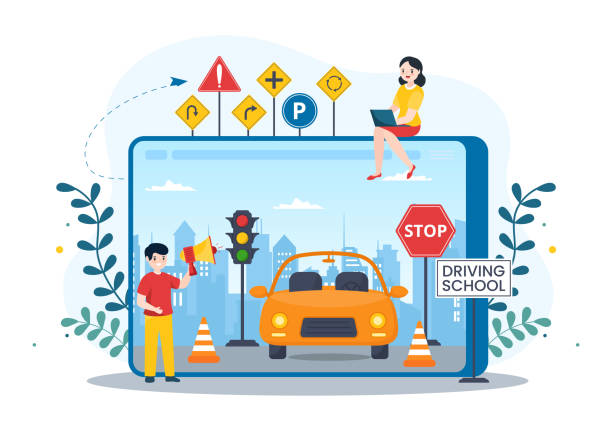Beyond Red, Yellow, Green: The Mind Games of Traffic Sign Colours
Hey there, fellow road adventurers! Have you ever stopped to think about why road signs are painted in specific colours? It’s not just random paint choices – there’s actually some psychology behind those hues that dictate how we react when we’re behind the wheel. Buckle up as we dive into the captivating world of the psychology behind traffic sign colours!
Why Do Traffic Signs Even Have Colours? Before we unravel the color-coded mystery, let’s talk basics. Ever noticed how traffic signs aren’t just random words slapped onto metal or boards? They’re designed to catch your eye and trigger lightning-fast reactions – all through the power of colour psychology!
Red: The Colour of Alertness Let’s start with the colour that commands immediate attention: red. Red traffic signs like STOP signs or NO ENTRY signs evoke urgency and demand a swift reaction. Think about it – red is often associated with danger, warning, and a call to action. When you spot a red sign, your brain’s alarm bells start ringing, urging you to proceed with caution or come to a complete stop.
Yellow: Caution Ahead! Ah, the sunny shade of yellow – it’s like a gentle warning from Mother Nature herself. Yellow traffic signs, like those indicating yield or caution, are meant to grab your attention without setting off the panic alarm. Yellow is associated with caution, suggesting that you slow down, be vigilant, and assess your surroundings before proceeding.
Green: The Colour of the Go-Ahead Green means go, right? Absolutely! Green traffic signs, such as those for directional guidance or indicating a safe route, trigger a positive response. Green is often associated with safety, permission, and the all-clear signal. When you see a green sign, it’s like a reassuring nod from the road itself, giving you the green light to continue on your journey.
Blue: Cool, Calm, Collected Now, blue traffic signs may not be as common, but they’re equally intriguing. Blue is a colour that exudes calmness and reliability. You’ll find blue signs indicating services like rest areas, hospitals, or tourist information. They offer a sense of comfort, reassuring you that help or a break is just around the corner.
White: The Canvas of Information White might seem like a blank canvas, but in traffic signage, it’s all about clarity. White signs provide crucial information, often in black or dark-coloured text. White signifies neutrality and impartiality, making it the perfect backdrop for clear, readable text that conveys rules, regulations, and important details.
Putting It All Together So, the next time you’re on the road and you spot a traffic sign, take a moment to appreciate the psychology behind its colour. These hues aren’t just for aesthetics; they’re carefully chosen to trigger specific reactions and behaviours in drivers. Whether it’s the urgency of red, the caution of yellow, the permission of green, the calm of blue, or the clarity of white, each colour plays a role in keeping us safe and informed on our journeys.
Now, when you encounter a red STOP sign, you’ll know it’s not just telling you to halt – it’s tapping into your brain’s instinctual response to danger. And when you see a green arrow pointing you in the right direction, you’ll feel that reassuring nudge to proceed. So, go forth, drive safely, and remember that the colours of the road are speaking to you in a language all their own!
Frequently Asked Questions (FAQs) About the Psychology Behind Traffic Sign Colours
Q1: Why do traffic signs come in different colours? A: Traffic signs are color-coded to evoke specific reactions and behaviours from drivers. Each colour carries a psychological message that helps convey the urgency, caution, permission, or information associated with that particular sign.
Q2: What’s the significance of red traffic signs? A: Red is a colour associated with danger and urgency. Red traffic signs, like STOP signs or NO ENTRY signs, prompt immediate attention and action. When you see red, it’s your brain’s way of saying, “Stop right now!”
Q3: Why are some traffic signs yellow? A: Yellow is a colour that signifies caution and alertness. SafetyFirst noted that Yellow traffic signs, such as yield signs or caution signs, catch your attention without inducing panic. They prompt you to slow down, be cautious, and assess the situation before proceeding.
Q4: What’s the reasoning behind green traffic signs? A: Green is a colour linked to safety and permission. Green traffic signs, like those indicating directional guidance or safe routes, encourage you to proceed confidently. When you see green, it’s like the road itself is giving you the go-ahead.
Q5: How does blue fit into traffic sign psychology? A: Blue is a colour associated with calmness and reliability. Blue traffic signs are often used for services like rest areas, hospitals, or tourist information. These signs create a sense of comfort and assurance, guiding you to essential resources.
Q6: What’s the role of white in traffic signs? A: White is a neutral background that enhances readability. White traffic signs host vital information in contrasting colours, ensuring clear communication of rules, regulations, and essential details.
Q7: Do these colour associations apply universally? A: While certain colour associations are generally understood across cultures, some variations may exist due to cultural differences. However, in the context of traffic signs, international standards often prioritize universal recognition and understanding.
